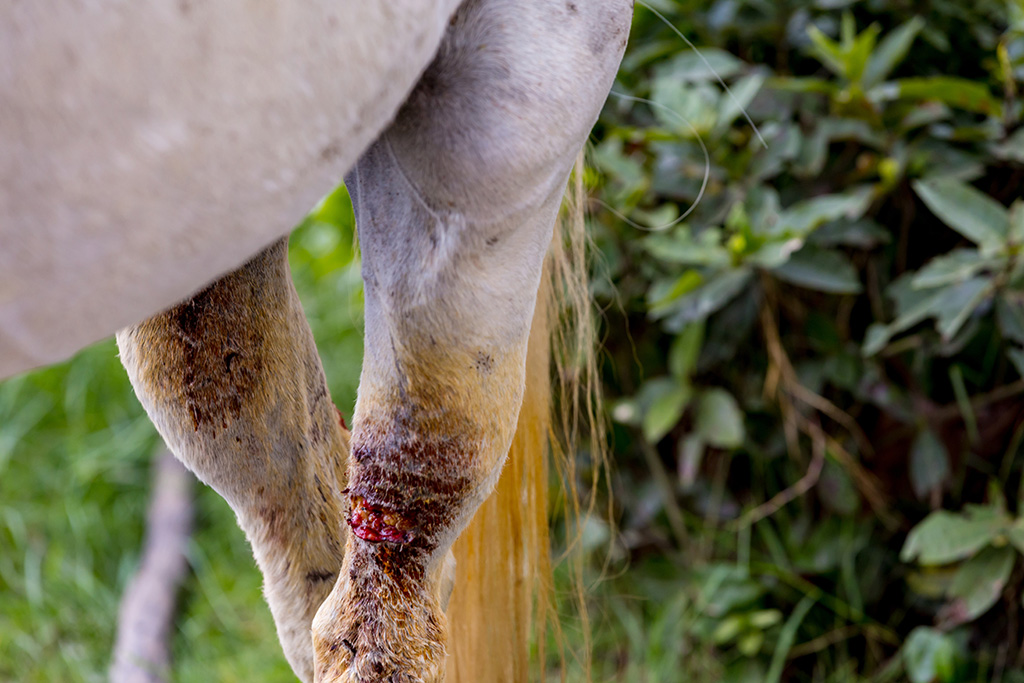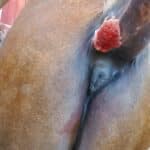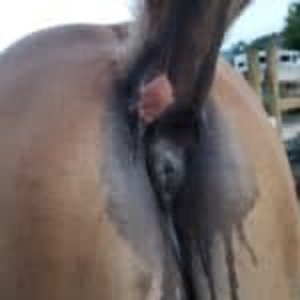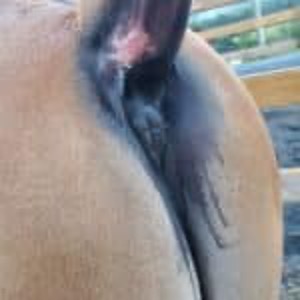While the term “proud flesh” may sound like a positive trait, it actually refers to a wound complication that requires immediate care. Proud flesh, also known as exuberant granulation tissue (EGT), is a common condition in horses and ponies. Although the exact causes of varying susceptibility are not fully understood, it is crucial to address proud flesh promptly to avoid further complications.
Proud flesh occurs when excessive granulation tissue grows at a wound site, obstructing the normal healing process and preventing new skin from forming. This overgrowth can lead to chronic wounds, scarring, and infection. While proud flesh can affect any horse, early identification and treatment are essential for effective recovery.
In this article, we will explore the definition, symptoms, causes, and treatment options for proud flesh in horses to help you manage this common yet challenging condition.
What is Exuberant Granulation Tissue (EGT) in Horses?
As a horse owner, it’s not uncommon to find a minor cut or wound on your horse’s leg. If the injury appears superficial and has stopped bleeding, many owners will reach for treatments like Banixx® Horse Spray and Banixx® Wound Care Cream to help support healing. However, even small wounds can sometimes become problematic if not monitored closely.
If, after a couple of weeks, the wound hasn’t healed properly and develops a pink, raised, bumpy appearance, it may be a case of proud flesh, or exuberant granulation tissue (EGT). This overgrowth of granulation tissue rises above skin level and interferes with the wound’s ability to close, preventing healthy skin from regenerating over the affected area.

You’ll usually find proud flesh forming in wounds below your horse’s knees and hocks, often over joints. That’s because there’s little soft tissue between skin and bone and the blood flow is shallow. Good blood flow is necessary for good healing since a good supply of blood carries oxygen and nutrients vital to a quicker recovery. Moreover, constant movement in the injured area tugs at the wound’s outer edges opening them again and again. In fact, these “edges” need to knit together to form a union. Initially there is usually some sort of scab that cements the edges together, falling off as the tissue completes its job of skin union.
If the injury is in another area of your horse’s body, it’s less likely that your equine companion will develop proud flesh. Reasoning is that the skin that covers the muscles isn’t under as much tension as in the leg area. Thus, in non-leg wounds, the horse’s movements don’t pull as hard on the edges of a wound that is trying to knit/heal.
What are the Symptoms of Proud Flesh in Horses?
Look for these signs around a cut or wound at risk of developing proud flesh:
- The area of the wound is raised above the surrounding skin
- The wound is very slow to heal or doesn’t heal at all
- Redness around the wound
- Lumps and bumps appear on the leg
- Cobblestone appearance
- The wound contains blood vessels
What Causes Proud Flesh?
Why does proud flesh develop even when the original wound didn’t seem serious? There are a few causes that are believed to be responsible:
- The wound is in an area of high motion, such as a leg joint. Accordingly, pressure on the wound and re-injury can create a cycle of inflammation that promotes EGT.
- Limited blood supply to the lower leg can hinder proper wound healing and promote EGT.
- Infection and contamination are always a concern. If dirt, hay, debris or bacteria get into the wound, this can stimulate EGT.
- EGT loves it when the wound is not treated properly. The cut needs to be cleaned, dressed and/or bandaged correctly.
- If treatment is delayed, it’s more prone to EGT. EGT can be triggered if the horse is being treated for other conditions with medicine that delays skin growth.
How Does a Vet Diagnose Proud Flesh?
Sometimes what looks like proud flesh may be something else, such as a fungal infection, tumor or other disease. Therefore, it’s best to get a diagnosis from your veterinarian.
An equine veterinarian will base a diagnosis on the appearance of the tissue. In addition, they will take into account your horse’s history of a wound in that area. A sample of the tissue may be taken for analysis. And they can check if there’s an infection and whether there are any foreign bodies in the wound. Often antibiotics used orally and oral NSAIDS such as Phenylbutazone Powder used in combination reduce swelling in EGT. They are used at the same time as Banixx Spray and cream.
In certain cases, the vet may determine that surgical removal of the overgrowth or skin grafting are needed.
How to Treat Proud Flesh in Horses
Step #1: Cleaning the wound and surrounding area is a crucial first step in treating equine injuries and helping prevent proud flesh formation. Ensure the wound is free of dirt, debris, and any foreign material. Start by using a povidone-iodine scrub, such as Aspen® Providine Iodine Scrub to thoroughly disinfect the area and prepare it for healing. To further support healing and prevent infection, you can use an antibacterial wound care product such as Banixx® Horse & Pet Care Spray.
After thoroughly cleaning the wound, apply a targeted treatment such as ProudsOff™ to help manage existing proud flesh and support healthy tissue regeneration. Once the area is clean and fully dry, a light topical application of ProudsOff™ or All-Purpose Nu-Stock® Ointment can be used—particularly on high-movement areas like the legs. Be sure to apply sparingly, as using too much product can trap moisture and hinder the healing process. Apply these items directly on the wound area lighting to avoid it dripping down the leg. If the area can’t be wrapped, spray fly spray such as EquiShield™ FG (Fly Guard) on the hock to avoid insects bringing infective material to the wound.
Your veterinarian should and remove foreign material, bone fragments, or dead tissue. These can cause inflammation and infection. In addition, a veterinarian should flush it immediately with a balanced saline solution. Once the wound is clean, apply an appropriate dressing and bandage on top of the treatment.
Make sure you don’t leave the bandage on longer than necessary. It can create an environment (low oxygen, moistness) that promotes EGT rather than stops it. Your vet can give you instructions in this regard. A wound needs to be moist aka lubricated for faster healing and less scarring. Don’t use a powder treatment for this. A dry wound takes longer to heal and is more likely to scar.
If the EGT is moderate to severe, treatment will require minor onsite surgery. The vet will excise granulation tissue that has grown higher/thicker than the skin surrounding it. This surgery is usually performed with the horse standing. Horses with large wounds and severe overgrowths of granulation tissue may require general anesthesia.
In some cases, your horse may need to have skin grafted to cover large wounds. This can promote faster healing and reduce scarring. In a skin graft, healthy skin is taken from one area of the body and transplanted onto the wound site.
The horse’s movement during recovery should be limited. Stall rest is recommended if the area with proud flesh is large or in a highly mobile area. But daily walks are a good idea (10-20 minutes) to prevent colic and promote good healing blood flow. Also, during the walk if grass is available that will be utmost preference. If the EGT wound is small (less than a silver dollar size), these horses can have faster turn out.
July 19

July 25

July 30

How Can I Prevent Proud Flesh in My Horse?
Exuberant granulation tissue (EGT) can quickly complicate a wound, so it’s important to act promptly when your horse sustains a cut or injury. Immediate and proper wound care can help prevent proud flesh and promote healthy healing. Here’s how to manage the wound effectively from the start:
- Flush the wound right away with Banixx Pet Spray.
- Examine the wound for foreign material, bone fragments or dead tissue.
- Remove any dead tissue or debris from the area with cotton or soft gauze.
- If the wound is minor, apply a topical ointment like Proudsoff™ or Banixx Wound Cream to help prevent infection that promotes EGT.
If the wound appears more serious, it is important to have it evaluated by a veterinarian as soon as possible. “Serious” wounds include those that are deep, cover a large area, or are located in critical areas such as joints or tendons.
- Use a pressure wrap bandage such as Co-Flex to hold the wound’s edges together and help keep the proud flesh from bulging again. But make sure the bandage doesn’t end up contributing more to the problem.
- Modify your horse’s exercise routine to give the wound a better chance to heal naturally. Reducing the amount of motion can make a big difference in the healing process but also note our above comments about grazing and limited activity.
- Your vet may recommend a medication that includes cortisone and/or antibiotics. Or they may recommend topical steroids to reduce inflammation.
Key nutrients like Vitamin C and Vitamin E play an important role in supporting wound healing and recovery in horses. While fresh pasture is a natural source of Vitamin E, supplementation with products like Health-E™ can help ensure your horse is receiving optimal levels—especially during times of stress or limited grazing. Health-E™ is an antioxidant to reduce swelling and is a versatile tool to increase blood flow and oxygen to the wound to speed healing.
Bottom Line: How There’s Hope for Curing Proud Flesh in Horses
Treating proud flesh in horses and eventually curing it takes patience. It may require weeks and months of persistent, repeated treatments, but keep at it. The prognosis for recovery is good! When treating cuts, wounds, or injuries in horses and ponies, using products like Banixx® Horse & Pet Care Spray or ProudsOff™ can help promote effective healing and minimize complications. ProudsOff™ is a specialized ointment designed to reduce scarring, support tissue regeneration, and assist in the removal of unsightly proud flesh.
Banixx® Spray offers a different yet complementary approach. Its unique pH-balanced formula creates an environment where bacteria and fungi cannot thrive, helping to prevent infection and the development of proud flesh. It is safe to use around the eyes, ears, and sensitive areas, making it ideal for treating leg scrapes or deeper skin abrasions.
Managing proud flesh in horses takes consistent care, proper wound management, and veterinary guidance. Always consult your equine veterinarian for the best results in treating proud flesh. With early intervention and the right treatment plan, you can reduce excessive granulation tissue, support healthy healing, and get your horse back on track. If you have further questions about equine proud flesh treatment options call us at 800.786.4751.
LEARN MORE:
Summer Sores in Horses: Causes, Treatment & Prevention
Learn how to identify, treat, and prevent summer sores in horses. This complete guide covers the causes of equine cutaneous habronemiasis, symptoms to watch for, deworming and fly control strategies, and effective treatment options to help your horse heal and stay healthy.
Equine Vaccination: Vaccinating Your Horse
What vaccines do horses need? Horse vaccination is important to protect against equine Encephalitis, tetanus in horses, horse flu and more.
Foal Deworming FAQs: Deworming Foals and Yearlings
Discover effective foal deworming strategies to protect your young horse from parasites and support healthy growth. Get tips for developing a foal deworming schedule.
Equine Deworming: Horse Intestinal Parasites
What are the most common intestinal parasites in horses? Learn the best horse deworming schedule, deworming products and equine parasite control tips to fight worms in horses like strongyles, ascarids and tapeworms.
Written by: Frank Reilly, DVM
Senior Doctor at Equine Medical & Surgical Associates
Frank Reilly, DVM has been in equine practice for 35+ years and has worked on six world-record racehorses. He is the Senior Doctor at Equine Medical & Surgical Associates, Inc. and a member of the AVMA, AAEP, NAEP, and IAPF. Dr. Reilly specializes in Equine Cushings, Insulin problems, Summer Eczema, Vitamin E deficiencies, COPD/Asthma, and Horse Foot Canker. Dr. Reilly is a 35+ year member of American Veterinary Medical Assoc. and the American Assoc. of Equine Practitioners. He is also a member of Pennsylvania Veterinary Association, the Northeast Assoc. of Equine Practitioners and is on the Board of Directors and Treasurer of Ryerss Farm-America’s First Horse Retirement and Rescue, established in 1888.
